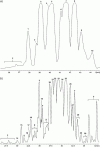Screening the biosphere: the fungicolous fungus Trichoderma phellinicola, a prolific source of hypophellins, new 17-, 18-, 19-, and 20-residue peptaibiotics
- PMID: 23681726
- PMCID: PMC3734673
- DOI: 10.1002/cbdv.201200339
Screening the biosphere: the fungicolous fungus Trichoderma phellinicola, a prolific source of hypophellins, new 17-, 18-, 19-, and 20-residue peptaibiotics
Abstract
To investigate the significance of antibiotics for the producing organism(s) in the natural habitat, we screened a specimen of the fungicolous fungus Trichoderma phellinicola (syn. Hypocrea phellinicola) growing on its natural host Phellinus ferruginosus. Results revealed that a particular group of non-ribosomal antibiotic polypeptides, peptaibiotics, which contain the non-proteinogenic marker amino acid, α-aminoisobutyric acid, was biosynthesized in the natural habitat by the fungicolous producer and, consequently, released into the host. By means of liquid chromatography coupled to electrospray high-resolution time-of-flight mass spectrometry, we detected ten 20-residue peptaibols in the specimen. Sequences of peptaibiotics found in vivo were independently confirmed by analyzing the peptaibiome of an agar plate culture of T. phellinicola CBS 119283 (ex-type) grown under laboratory conditions. Notably, this strain could be identified as a potent producer of 39 new 17-, 18-, and 19-residue peptaibiotics, which display the same building scheme as the 20-residue peptaibols found in the specimen. Two of the 19-residue peptaibols are tentatively assigned to carry tyrosinol, a novel C-terminal residue, as deduced from high-resolution tandem mass-spectrometry data. For the new peptaibiotics produced by T. phellinicola, the name 'hypophellin(s)', based on the teleomorph name, is introduced.
Copyright © 2013 Verlag Helvetica Chimica Acta AG, Zürich.
Figures




Similar articles
-
Hypopulvins, novel peptaibiotics from the polyporicolous fungus Hypocrea pulvinata, are produced during infection of its natural hosts.Fungal Biol. 2012 Dec;116(12):1219-1231. doi: 10.1016/j.funbio.2012.10.003. Epub 2012 Oct 26. Fungal Biol. 2012. PMID: 23245616 Free PMC article.
-
Sequences of stilboflavin C: towards the peptaibiome of the filamentous fungus Stilbella (= Trichoderma) flavipes.J Pept Sci. 2016 Aug;22(8):517-24. doi: 10.1002/psc.2897. J Pept Sci. 2016. PMID: 27443977
-
Front line defenders of the ecological niche! Screening the structural diversity of peptaibiotics from saprotrophic and fungicolous Trichoderma/Hypocrea species.Fungal Divers. 2014 Nov 1;69(1):117-146. doi: 10.1007/s13225-013-0276-z. Fungal Divers. 2014. PMID: 25722662 Free PMC article.
-
Recent advances and future prospects in peptaibiotics, hydrophobin, and mycotoxin research, and their importance for chemotaxonomy of Trichoderma and Hypocrea.Chem Biodivers. 2008 May;5(5):671-80. doi: 10.1002/cbdv.200890064. Chem Biodivers. 2008. PMID: 18493954 Review.
-
Peptaibols and related peptaibiotics of Trichoderma. A review.Acta Microbiol Immunol Hung. 2005;52(2):137-68. doi: 10.1556/AMicr.52.2005.2.2. Acta Microbiol Immunol Hung. 2005. PMID: 16003936 Review.
Cited by
-
Hyporientalin A, an anti-Candida peptaibol from a marine Trichoderma orientale.World J Microbiol Biotechnol. 2018 Jun 19;34(7):98. doi: 10.1007/s11274-018-2482-z. World J Microbiol Biotechnol. 2018. PMID: 29922855
-
Diversity of Linear Non-Ribosomal Peptide in Biocontrol Fungi.J Fungi (Basel). 2020 May 12;6(2):61. doi: 10.3390/jof6020061. J Fungi (Basel). 2020. PMID: 32408496 Free PMC article. Review.
-
Visualizing fungal metabolites during mycoparasitic interaction by MALDI mass spectrometry imaging.Proteomics. 2016 Jun;16(11-12):1742-6. doi: 10.1002/pmic.201500510. Epub 2016 Apr 13. Proteomics. 2016. PMID: 26959280 Free PMC article.
-
Pathogenicity of Trichoderma afroharzianum in Cereal Crops.Pathogens. 2023 Jul 14;12(7):936. doi: 10.3390/pathogens12070936. Pathogens. 2023. PMID: 37513783 Free PMC article.
-
Biological role of Trichoderma harzianum-derived platelet-activating factor acetylhydrolase (PAF-AH) on stress response and antagonism.PLoS One. 2014 Jun 25;9(6):e100367. doi: 10.1371/journal.pone.0100367. eCollection 2014. PLoS One. 2014. PMID: 24964161 Free PMC article.
References
-
- Hawksworth DL. Mycol. Res. 2001;105:1422.
-
- Kirk PM, Cannon PF, Minter DW, Stalpers JA, editors. 10th edn. Wallingford, Oxon: CABI Europe; 2008. ‘Dictionary of Fungi’.
-
- Bérdy J. J. Antibiot. 2012;65:385. corrigendum in J. Antibiot201265, 441. - PubMed
-
- Laatsch H. ‘Antibase 2012 SciDex – The Natural Compounds Identifier’, Wiley-VCH, Weinheim, 2012.
-
- Cragg GM, Grothaus PG, Newman DJ. in ‘Plant Bioactives and Drug Discovery: Principles, Practice, and Perspectives’, 4th edn., Ed. V. Cechinel-Filho, John Wiley & Sons, Hoboken, 2012, p. 1.
Publication types
MeSH terms
Substances
Grants and funding
LinkOut - more resources
Full Text Sources
Other Literature Sources
Miscellaneous

